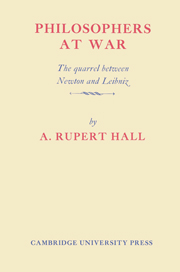Book contents
- Frontmatter
- Contents
- Preface
- Chronological Outline
- 1 Introduction
- 2 Beginnings in Cambridge
- 3 Newton states his claim: 1685
- 4 Leibniz encounters Newton: 1672–1676
- 5 The emergence of the calculus: 1677–1699
- 6 The outbreak: 1693–1700
- 7 Open warfare: 1700–1710
- 8 The philosophical debate
- 9 Thrust and parry: 1710–1713
- 10 The dogs of war: 1713–1715
- 11 War beyond death: 1715–1722
- Appendix: Newton's “Account of the Book entituled Commercium Epistolicum”
- Notes
- Index
3 - Newton states his claim: 1685
Published online by Cambridge University Press: 16 October 2009
- Frontmatter
- Contents
- Preface
- Chronological Outline
- 1 Introduction
- 2 Beginnings in Cambridge
- 3 Newton states his claim: 1685
- 4 Leibniz encounters Newton: 1672–1676
- 5 The emergence of the calculus: 1677–1699
- 6 The outbreak: 1693–1700
- 7 Open warfare: 1700–1710
- 8 The philosophical debate
- 9 Thrust and parry: 1710–1713
- 10 The dogs of war: 1713–1715
- 11 War beyond death: 1715–1722
- Appendix: Newton's “Account of the Book entituled Commercium Epistolicum”
- Notes
- Index
Summary
In the summer of 1685, perhaps not long after the defeat of Monmouth at Sedgemoor, Isaac Newton in his rooms by the Great Gate of Trinity College, Cambridge, was absorbed in writing the earliest version of his Mathematical Principles of Natural Philosophy, a majestic work whose beginning was still only about a year past. In August 1684 Edmond Halley, one of the secretaries of the Royal Society, a competent mathematician and an astronomer with some years of practical experience, had ridden the fifty miles from London to Cambridge expressly to put to the Lucasian professor a technical question that London mathematicians had failed to solve:
What he thought the curve would be that would be described by the planets supposing the force of attraction towards the Sun to be reciprocal to the square of their distance from it.
Newton at once answered – too precisely – that the orbit would be an ellipse. Halley, “struck with joy and amazement, asked him how he knew it; Why, saith he, I have calculated it; whereupon Dr. Halley asked him for his calculation without any further delay.” But the paper could not be found then and there, and Halley had to return to London with Newton's promise, soon fulfilled, that the demonstration would be sent to him there.
On 10 December 1684 Halley spoke of the work that Newton was engaged upon to the Royal Society in London, and Newton must by then have embarked already upon a large-scale treatment.
- Type
- Chapter
- Information
- Philosophers at WarThe Quarrel between Newton and Leibniz, pp. 24 - 43Publisher: Cambridge University PressPrint publication year: 1980



